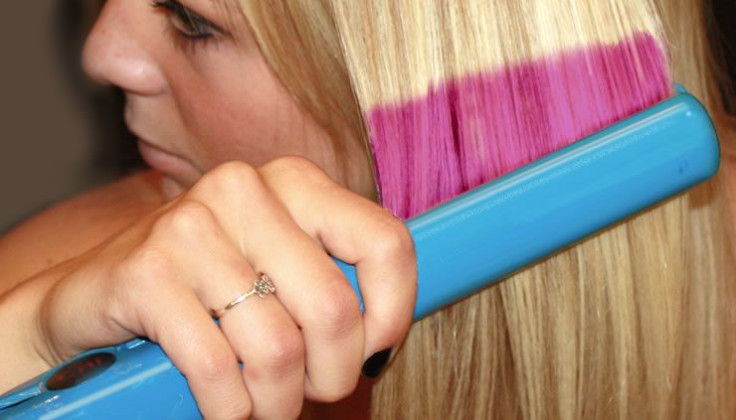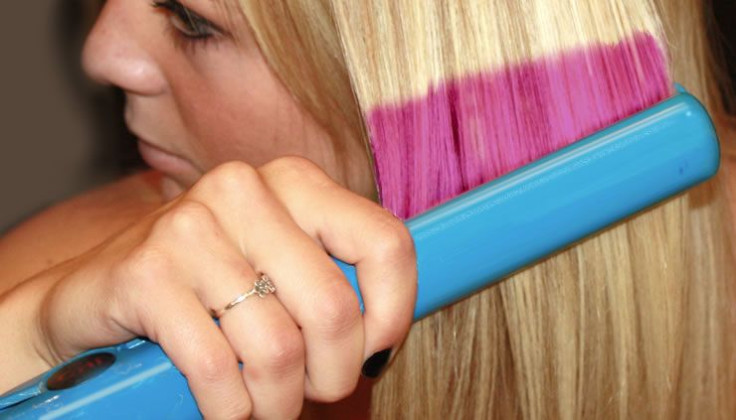Flat Iron Device Changes Natural Hair Color With Ion Beam Technologies: Is This The End Of Hair Dye?

There is no avoiding the dreaded strands of gray hairs that begin to fill the heads of men and women as early as high school or college. While changes in hair are a sign of aging, it is also a sign that we must make an appointment with our hair dresser, or go to the nearest pharmacy and choose our go-to hair dye brand. These hair woes are often and troubling, but engineers at the University of New Mexico and Los Alamos National Laboratories have introduced a flat iron-like device to change natural hair color with just the touch of a button, using ion beam technologies, according to a study published in the Journal of Cosmetics, Dermatological Sciences and Applications.
Currently, Bruce Lamartine and Zayd Leseman, mechnical engineering professors, are exploring a way to etch “different gratings” on individual hairs to reflect light in a specific way. According to the University of New Mexico news release, the device would etch the diffraction gratings into the hair, and the color would depend on the portion of the light spectrum that was reflected. Users of the device can even change “paddles” on it depending on what color they want their hair to be, and can even create patterns in it by changing the diffracted color.
The flat iron can achieve the desired effect with the use of ion beam technologies, specifically focused ion beam, which is already used in the manufacturing of electronics. The patterns — Archimedean spirals and hyperbola patterns — are used to reflect light in a way that it appears to change color. The color would depend on the portion of the light spectrum that was reflected.
"That’s one way to do it, to make the pattern directly onto your hair, your permanent hair and that would be more of a permanent change until it grows out," said Leseman in the news release. The other idea Leseman and Lamartine have is to develop some kind of conditioner, or polymer coating for the hair. This method will allow the user to actually pattern the conditioner or the polymer on the hair first, and then easily wash it out if the user wants it to go away.

The five-year-long project is still in development, but the device has been tested on black, brown, and blonde hair, and works best on brunettes. The introduction of this device on the market could officially put an end to hair dyes, and even allow those with dye allergies or skin sensitivity to dye their hair.
Hair dyes have long been associated with the risk of cancer, since early hair dye formulas contained chemicals that were found to cause cancer in animals before the 1980s. In the mid- to late-1970s, according to the National Cancer Institute, manufacturers changed the ingredients in hair dye products to eliminate chemicals which have been associated with a greater risk of developing non-Hodgkin's lymphoma.
Both men and women in the U.S. and Europe use hair dyes. Modern hair dyes are classified as permanent, semipermanent, and temporary. With more than one-third of women over the age of 18, and about 10 percent of men over age 40 using some type of hair dye, it is imperative to protect our hair strands, and most importantly our health.
Although professional hair dye jobs are still a big contributor to the beauty industry, many of us should rethink this treatment. Ni'Kita Wilson, cosmetic chemist and CEO of Catalyst Cosmetic Development, told The Huffington Post for hair dye to work, ammonia literally lifts up the hair cuticle so the dye can penetrate through the cuticle itself. Ammonia elevates the pH of the hair, which relaxes the cuticle and lifts it up. "The problem with that is once you've disturbed the cuticle, the damage has started because the cuticle is not meant to be lifted up," Wilson said.
It seems this flat iron device could help us hide our grays while having healthier hair, without the chemicals. The scientists are also using the same technology outside the cosmetics industry for security measures on credit card readers, and to identify a friend from an enemy on the battle field.
Source: Abbas K, Goettler DF, Lamartine BC, Leseman ZC. Nano-Patterning of Diffraction Gratings on Human Hair for Cosmetic Purposes. Journal of Cosmetics, Dermatological Sciences and Applications. 2014.



























